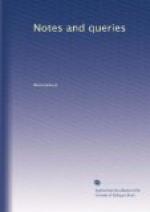ROBERT SNOW.
6. Chesterfield Street, Mayfair, Jan. 13. 1851.
Dodo Queries (Vol. i., pp. 261, 262.).—MR. STRICKLAND is informed, that in the list of Pingre’s works, as given in Querard’s France Litteraire, there is one with the following title:—
“Memoire sur les Decouvertes
faites dans la Mer du Sud, avant les
derniers Voyages des Francais
autour du Monde, lu a l’Academie des
Sciences, 1766, 1767, 1778,
in. 4.”
I have not read Pingre’s works, but if they contain any mention of Solitaires, it will probably be found in the Memoire above referred to.
HENRY H. BREEN.
St. Lucia, W.I., Nov. 1850.
Holland Land (Vol. ii., pp. 267. 345.; Vol. iii., p. 30).—In an ancient charter, in my possession, bearing date 19 Edw. I.: “Gilebertus dictus ate Vorde, de Farlegh,” and “James, son of the late Philip de Essche,” quitclaim to James, son of Paulinus de Wynchelse:
“dimidiam acram terre Flandrensis ... in villa de Ickelesham,”
to have and to hold
una cum redditu et servitio
mihi (sic) pertinentibus de alia dimidia
acra terre Flandrensis.”
The polders of Holland are familiar to all travellers, as lands lying below the level of the sea, once a mere morass, redeemed from that state, and brought into cultivation by embankments, &c., &c.
In another charter, somewhat earlier in date and relating to the same district, viz. the neighbourhood of Winchelsea, Hamo de Crevecour speaks of lands in La more in Ideun, which the monks of Robertsbridge, with consent of his father Hamo, “a mari incluserunt.”
I have always supposed that the “terra Flandrensis” of my charter signified land of the same description as the Dutch polders; the art of thus redeeming land being probably introduced from the Low Countries. It is not unlikely that, in that day, lands so brought into cultivation were designated as “terre Flandrenses,” and the term afterwards anglicised into “Holland Land.”
L.B.L.
Swearing by Swans (Vol. ii., p. 392.).—Symbology of the swan.
“Tunc allati sunt in
pompatica gloria duo cygni, vel olores, ante
regem, &c. &c.,—vindicaturus."[12]—Matthaeus
Westmonasteriensis.
Dr. Lingard states that “the vows of chivalry were not taken on the gospels, but, ridiculous as it may appear, in the presence of a peacock, or {71} pheasant, or other bird of beautiful plumage.”—History of England, Edward I.
“Nec dissimili ingenio Heraldi antiquiores, musicos et cantatores cygnis[13] donarunt. Ejusque haud ignarus perspicax noster Franciscanus cum hos a non cantoribus latos observasset, rationem se ait a rege heraldorum petiisse, eumque duplicem assignasse: hanc quia viri essent pulcherrimi, illam quia haberent longa colla. Sane candorem animi per cygni effigiem antiquitus praedicabant, nec insulse igitur corporis. Sed gloriae studium ex eodem hoc symbolo indicari multi asserunt.




